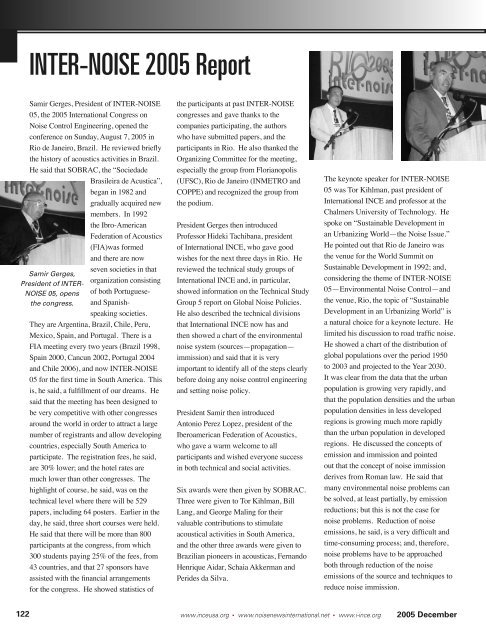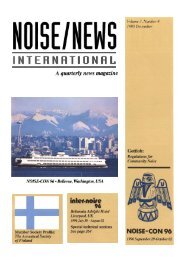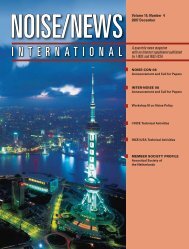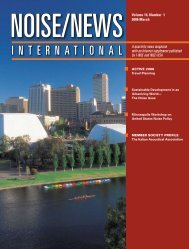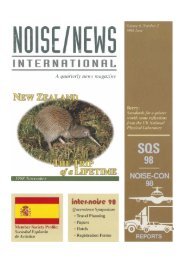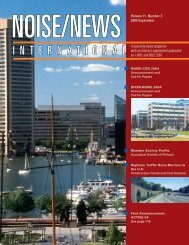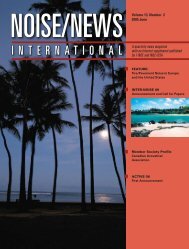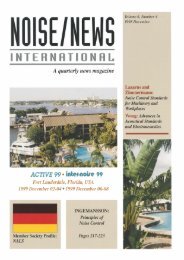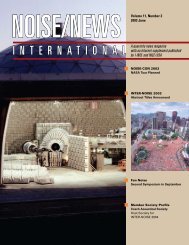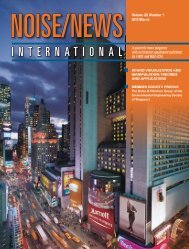Download - Noise News International
Download - Noise News International
Download - Noise News International
- No tags were found...
Create successful ePaper yourself
Turn your PDF publications into a flip-book with our unique Google optimized e-Paper software.
INTER-NOISE 2005 ReportSamir Gerges, President of INTER-NOISE05, the 2005 <strong>International</strong> Congress on<strong>Noise</strong> Control Engineering, opened theconference on Sunday, August 7, 2005 inRio de Janeiro, Brazil. He reviewed brieflythe history of acoustics activities in Brazil.He said that SOBRAC, the “SociedadeBrasileira de Acustica”,began in 1982 andgradually acquired newmembers. In 1992the Ibro-AmericanFederation of Acoustics(FIA)was formedand there are nowSamir Gerges,President of INTER-NOISE 05, opensthe congress.seven societies in thatorganization consistingof both PortugueseandSpanishspeakingsocieties.They are Argentina, Brazil, Chile, Peru,Mexico, Spain, and Portugal. There is aFIA meeting every two years (Brazil 1998,Spain 2000, Cancun 2002, Portugal 2004and Chile 2006), and now INTER-NOISE05 for the first time in South America. Thisis, he said, a fulfillment of our dreams. Hesaid that the meeting has been designed tobe very competitive with other congressesaround the world in order to attract a largenumber of registrants and allow developingcountries, especially South America toparticipate. The registration fees, he said,are 30% lower; and the hotel rates aremuch lower than other congresses. Thehighlight of course, he said, was on thetechnical level where there will be 529papers, including 64 posters. Earlier in theday, he said, three short courses were held.He said that there will be more than 800participants at the congress, from which300 students paying 25% of the fees, from43 countries, and that 27 sponsors haveassisted with the financial arrangementsfor the congress. He showed statistics ofthe participants at past INTER-NOISEcongresses and gave thanks to thecompanies participating, the authorswho have submitted papers, and theparticipants in Rio. He also thanked theOrganizing Committee for the meeting,especially the group from Florianopolis(UFSC), Rio de Janeiro (INMETRO andCOPPE) and recognized the group fromthe podium.President Gerges then introducedProfessor Hideki Tachibana, presidentof <strong>International</strong> INCE, who gave goodwishes for the next three days in Rio. Hereviewed the technical study groups of<strong>International</strong> INCE and, in particular,showed information on the Technical StudyGroup 5 report on Global <strong>Noise</strong> Policies.He also described the technical divisionsthat <strong>International</strong> INCE now has andthen showed a chart of the environmentalnoise system (sources—propagation—immission) and said that it is veryimportant to identify all of the steps clearlybefore doing any noise control engineeringand setting noise policy.President Samir then introducedAntonio Perez Lopez, president of theIberoamerican Federation of Acoustics,who gave a warm welcome to allparticipants and wished everyone successin both technical and social activities.Six awards were then given by SOBRAC.Three were given to Tor Kihlman, BillLang, and George Maling for theirvaluable contributions to stimulateacoustical activities in South America,and the other three awards were given toBrazilian pioneers in acousticas, FernandoHenrique Aidar, Schaia Akkerman andPerides da Silva.The keynote speaker for INTER-NOISE05 was Tor Kihlman, past president of<strong>International</strong> INCE and professor at theChalmers University of Technology. Hespoke on “Sustainable Development inan Urbanizing World—the <strong>Noise</strong> Issue.”He pointed out that Rio de Janeiro wasthe venue for the World Summit onSustainable Development in 1992; and,considering the theme of INTER-NOISE05—Environmental <strong>Noise</strong> Control—andthe venue, Rio, the topic of “SustainableDevelopment in an Urbanizing World” isa natural choice for a keynote lecture. Helimited his discussion to road traffic noise.He showed a chart of the distribution ofglobal populations over the period 1950to 2003 and projected to the Year 2030.It was clear from the data that the urbanpopulation is growing very rapidly, andthat the population densities and the urbanpopulation densities in less developedregions is growing much more rapidlythan the urban population in developedregions. He discussed the concepts ofemission and immission and pointedout that the concept of noise immissionderives from Roman law. He said thatmany environmental noise problems canbe solved, at least partially, by emissionreductions; but this is not the case fornoise problems. Reduction of noiseemissions, he said, is a very difficult andtime-consuming process; and, therefore,noise problems have to be approachedboth through reduction of the noiseemissions of the source and techniques toreduce noise immission.122 www.inceusa.org • www.noisenewsinternational.net • www.i-ince.org 2005 December


